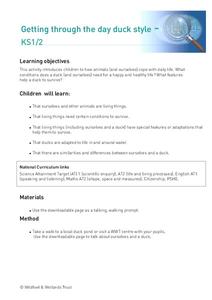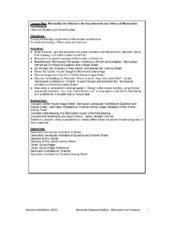Curated OER
Spider
Learners use a spider casting kit to mold a tarantula spider. They discuss the tarantula, its parts, and its habitat.
Curated OER
North American Animals
Students are introduced to the anatomy and characteristics of the North American wolf, grizzly bear and bobcat through a purchased kit. They cast plaster models of each of the animals for study and display.
Curated OER
Investigating Convection Currents
Students examine how differences in the temperature and salinity of the water help create ocean currents. They perform an experiment which shows how temperature affects the circulation of ocean water.
Curated OER
The Need For Shelter
Fifth graders build a shelter to protect themselves from rain. They perform durability and water proof testing on the shelters. They make observations of plants found in the Amazon rainforest.
Curated OER
Mixed Media Painting
Students create mixed media still life paintings in this "Happy Accident" art lesson introducing the concepts of using pen and ink, watercolors, and pastels. The lesson can be adapted for various grade levels and abilities ranging from...
Curated OER
Are Seeds in Danger?
Eighth graders discuss uses and disposal of common household chemicals. They select a household chemical to test for impact on plant germination. Students decide how they want to set up a seed germination project. They design their plan,...
Curated OER
Getting through the day duck style
Students are introduced to how animals (and ourselves) cope with daily life. They discover that living things need certain conditions to survive. Students investigate how living things (including ourselves and a duck) have special...
Curated OER
Skin Cancer Prevention
In this health worksheet, students find the words related to the concept of skin cancer and the answers are found by clicking the button found at the bottom of the page.
Curated OER
What is a Plant?
In this plant worksheet, high schoolers will review the origins and adaptations of plants including the alternation of generations. This worksheet has 8 short answer, 6 fill in the blank, and 4 multiple choice questions.
Curated OER
Assorted Facts
In this research skills worksheet, students use any source of information to find the answers to 10 multiple choice questions on a variety of subjects.
Curated OER
Duck
In this ducks worksheet, students read information paragraphs about the habitat, reproduction, feeding and adaptation of ducks. Students study the photograph of the bird. There are no questions to answer here.
Curated OER
Mold It
Pupils make molds of various items of their choosing using the Molt-It kit. They discuss the scientific value of making molds.
Curated OER
Properties of Materials
In this material properties worksheet, students complete 6 activities in which they learn about and explore the differences between materials and properties. They collect objects and list off the materials and properties, answer...
Curated OER
Rainy Day Hike
Students develop awareness about the water cycles. They identify the watershed in which their school is located. They explain the role the schoolyard plays in the watershed.
Curated OER
Many Chairs, One Table
Students examine artwork and sculpture by Keith Haring. They decorate a chair with their own symbols and designs.
Curated OER
What is a Watershed, Anyway?
Students constrct a watershed and write about their observations. Students use maps to locate their area in relation to the watershed and inquire about what is applied to the ground above.
Curated OER
Keeping Cool
Students investigate the air conditioner units around the school. They chart the temperature by placing a thermometer in different situations and decide how to keep cool and save energy in the summer.
Curated OER
Wetlands/Watershed Model
Students work together to create a watershed model. They discover the flow of surface water on different topography. They examine how materials originate from miles away and end up in a different wetland.
Curated OER
Porcelain And Trade Economics
Students discover the concepts of importing and exporting through the study of Asian luxury goods, in particular porcelain. This activity includes resource links to primay source images.
Curated OER
Chinese And Japanese Tomb Cultures
Students examine burial customs in ancient China and Japan comparing those customs to burial traditions from other cultures. This lesson leads to group creative projects of mock "tombs".
Curated OER
Landfills and the Potential for Groundwater Contamination
Young scholars examine how a sanitary landfill is constructed, how it functions, and how waste and leachate affects the areas around the landfill. After a discussion about landfills and leachates, students construct a Sanitary Landfill...
Curated OER
Bermudian Vernacular Architecture
Young scholars, after researching, discussing and analyzing vernacular architecture in detail, answer a question and answer sheet, review an extensive vocabulary of key words, complete an activity sheet on the key words, and critique a...
Curated OER
Mapping A Stream
Students participate in mapping an actual waterway. They include reach lengths, transects, compass reading, and scale determinations. They include windfalls, plant cover, types of streambed composition, and landmarks such as trees and...

























